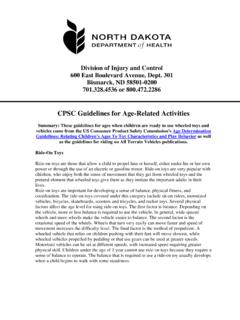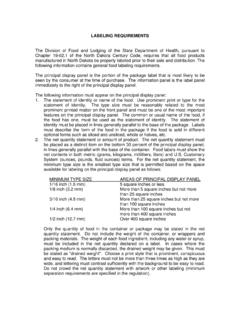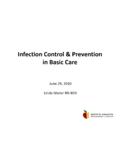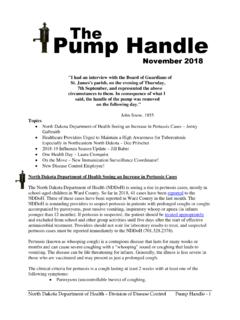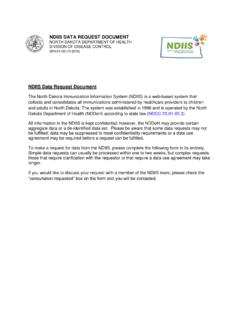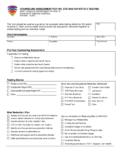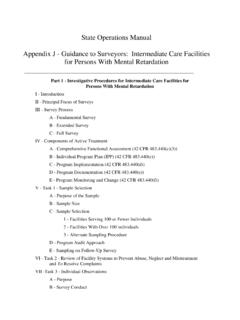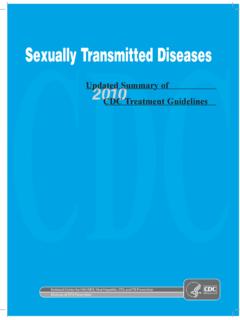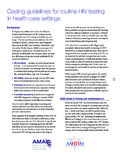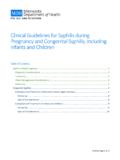Transcription of HIV and Hepatitis C Counseling, Testing and …
1 HIV and Hepatitis C counseling , Testing and referral site policies and procedures 2016 The policies and procedures on the following pages are applicable to all sites receiving reimbursement through the North Dakota Department of Health for HIV and Hepatitis C counseling , screening, Testing and vaccination activities. The policies may or may not be applicable to other agencies involved in Testing . North Dakota Department of Health Division of Disease Control 2635 E. Main Ave. Bismarck, ND 58506 Telephone Fax Table of Contents Contact Information .. 5 Program Goals for counseling , Testing and referral Sites .. 7 Eligibility Screening for Testing .. 9 HIV Testing .. 9 HCV Testing .. 9 Testing Services Not Provided .. 10 counseling at CTR Sites .. 11 counseling Negative Individuals .. 12 counseling Newly Identified HIV and/or HCV Confirmed Positive Individuals.
2 12 Test Methods Offered at CTR Sites .. 13 Rapid Testing .. 13 Confirmatory Testing .. 13 Reporting & Documentation .. 14 Control Logs .. 14 Temperature Logs .. 15 Required Data Submission .. 17 policies and Statutes for HIV and HCV Testing .. 19 Consent .. 19 Mandatory HIV and HCV Testing .. 19 Disclosure of HIV & Viral Hepatitis Status of an Inmate .. 19 Record Maintenance, Location and Retention Policy .. 20 Confidentiality .. 21 Viral Hepatitis Vaccine .. 23 Staff Development and Training Policy .. 25 New Employee Training Requirements .. 25 Continuing Education .. 25 HIV Prevention and Viral Hepatitis Biannual site Visit .. 27 Quality Management and Quality Improvement .. 29 Grant Awards & Contracts for CTR Program .. 31 Reimbursement for Testing , counseling and Vaccination .. 33 HIV and HCV Testing at Outreach Events .. 35 Ordering Prevention and Testing Supplies.
3 37 CTR policies and procedures Manual Last Updated: January 2016 4 CTR policies and procedures Manual Last Updated: January 2016 5 Contact Information Mailing Address: North Dakota Department of Health Phone: (701) 328-2378 or (800) 472-2180 Division of Disease Control Fax: (701) 328-2499 2635 E. Main Avenue HIV Confidential Fax: 701-328-0356 Bismarck, ND 58506 Website: Title* Phone Hepatitis Program Manager (701) 328-4555 Hepatitis Prevention Coordinator (701) 328-2366 Hepatitis Surveillance Coordinator (701) 328-1059 Administrative Assistant (701) 328-2376 *Current personnel are listed at: Questions should be directed as follows: Reimbursement & Contracts: Hepatitis Program Manager CTR Program Operations & procedures : Hepatitis Prevention Coordinator Hepatitis Case Reporting: Hepatitis Surveillance Coordinator Ordering of Supplies and Educational Materials: Administrative Assistant CTR policies and procedures Manual Last Updated: January 2016 6 CTR policies and procedures Manual Last Updated.
4 January 2016 7 Program Goals for counseling , Testing and referral Sites The HIV and Viral Hepatitis Programs of the North Dakota Department of Health (NDDoH) and the Division of Disease Control aim to reduce the spread of HIV and viral Hepatitis , to reduce illness and death and to promote the health and well-being of people with or at risk for these diseases. The goal is to offer HIV and Hepatitis C Testing at counseling , Testing and referral (CTR) sites to increase accessibility to healthcare services for populations at risk. CTR sites aim to inform clients knowledge of their HIV and HCV status, counsel and support risk reduction and secure needed referrals ( medical, social, prevention and partner services). The program is committed to upholding the vision of the National HIV/AIDS strategy, which states: The United States will become a place where new HIV infections are rare and when they do occur, every person, regardless of age, gender, race/ethnicity, sexual orientation, gender identity or socio-economic circumstance, will have unfettered access to high quality, life-extending care, free from stigma and discrimination The program also focuses on completing activities of the Viral Hepatitis HHS Action Plan for the Prevention, Care and Treatment of Viral Hepatitis .
5 Increasing the percent of persons who are aware of their Hepatitis C virus (HCV) infection is one goal of the action plan that is accomplished at CTR sites through Testing of at-risk individuals. The following are core elements that are essential to all CTR sites: 1. Ensure that CTR is a voluntary service that can only be delivered after informed consent is obtained. 2. Provide information and education to the client about HIV and HCV. 3. Provide client-focused HIV/HCV prevention counseling . 4. Establish clear and easy guidelines and sobriety standards to help counselors determine when clients are not competent to provide consent. 5. Use an HIV and HCV Testing technology approved by the Food and Drug Administration (FDA). Testing technology available to sites will be determined by the NDDoH. 6. Deliver test results in a manner that is supportive and understandable to the client.
6 7. Assess referrals in support of risk reduction or medical care, provide appropriate referrals and help link clients with referral services. A system must be in place for emergency medical or mental health referrals, if needed. 8. Track referrals made and completed. In addition to the required activities associated with the core elements, CTR sites are recommended to provide comprehensive services, which could include Sexually Transmitted Disease (STD) Testing , Human Papilloma Virus (HPV) vaccination and viral Hepatitis vaccination at every opportunity. In addition to providing services to incoming clientele, CTR sites, in partnership with the NDDoH and the Community Planning Group (CPG), may offer CTR policies and procedures Manual Last Updated: January 2016 8 outreach services in the community such as rapid Testing at health fairs, community events or stand-alone Testing events targeting high risk individuals.
7 Table 1 below summarizes the required and recommended activities performed at CTR sites. A yearly contract is maintained with CTR sites that allow CTR sites to be reimbursed for Testing , counseling , vaccine administration fees and other agreed upon expenses. In order to be reimbursed, the CTR site needs to meet standards outlined in this manual and submit required data and other required documentation. Table 1 . Required and Recommended CTR Activities Required Activities Recommended Activities Obtaining Consent Outreach events HIV/ Hepatitis C rapid & confirmatory Testing Community education Pre- and post-test counseling STD Testing Risk reduction planning Hepatitis A & B vaccination Data submission for all tests performed HPV vaccination Resource referrals Case management Provide client education Partner services CTR policies and procedures Manual Last Updated: January 2016 9 Eligibility Screening for Testing Testing supported at CTR sites by the NDDoH is available to individuals considered to be at risk for HIV and/or Hepatitis C.
8 Testing should be prioritized for uninsured or underinsured individuals. Individuals seeking Testing need to complete a risk assessment. The data from a risk assessment is required to be submitted to the NDDoH for every test performed. There is not a mandatory risk assessment form that needs to be completed, but the risk assessment does need to collect certain data fields. These data fields are described in the document CTR Sites Required Data Submission available at An example of a risk assessment is also available on this website. Counselors should use the information from a risk assessment to determine which screenings are recommended for an individual. The risk assessment is also used to develop an individual specific risk reduction plan. HIV Testing Testing should be provided for people who are or have had: Multiple sex partners: (having one or more sexual partners in the last 6 mos.)
9 Had unprotected sex: (vaginal, anal or oral sex without protection barriers) Current or past injection drug users Partners of injection drug users Partners of HIV-infected persons Persons diagnosed with tuberculosis (TB), HCV or a sexually transmitted disease (STD) Men who have sex with men (MSM) Tattoos or body piercings in unsterile environments Persons who exchange sex for money or drugs Patients that are at risk for HIV infection should be screened at least annually. Patients that are considered at high risk for HIV infection may be screened every three to six months. Those at high risk include: Sex Partners of HIV-infected persons Injection drug users and their sex partners Persons who exchange sex for money or drugs MSM or heterosexual persons who have had, or whose sex partners have had more than one sex partner since their most recent HIV test HCV Testing Those that have current risk behaviors should be screened at least annually.
10 People at risk include those who: Currently inject drugs or have shared needles, syringes, straws and other equipment Injected drugs in the past, even if it was once or many years ago Have had tattoos or body piercings in unsterile environments Have received blood clotting factors before 1987 Have HIV or AIDS CTR policies and procedures Manual Last Updated: January 2016 10 Have had sex with an HIV-infected individual Have undiagnosed liver problems Have received donated blood or organs before 1992 Are on long term hemodialysis Have had sex with men who have sex with men (MSM) Rates of HIV infection, viral Hepatitis , STDs and TB are substantially higher among persons who use drugs illicitly than among person who do not use drugs. The term "illicit use of drugs" encompasses all levels of use, abuse, and dependence because each level is associated with behaviors that increase the risk for contracting or transmitting infectious diseases.
